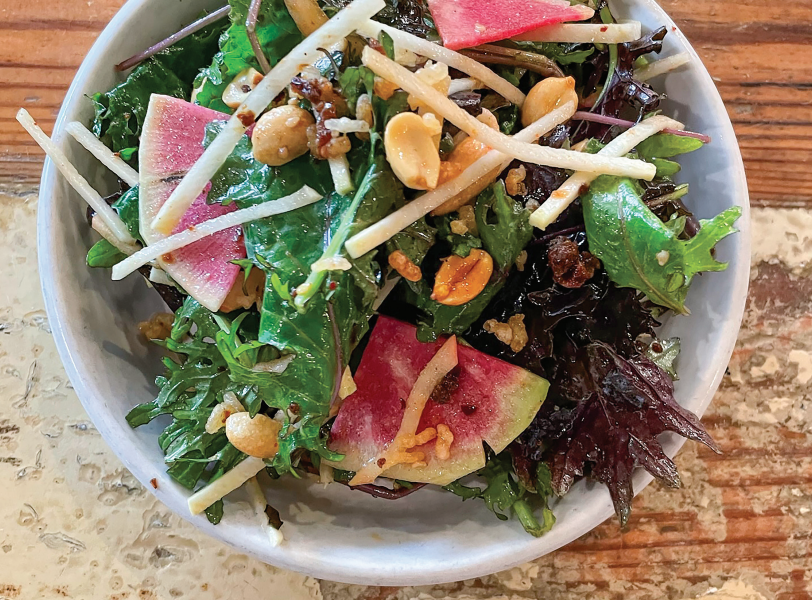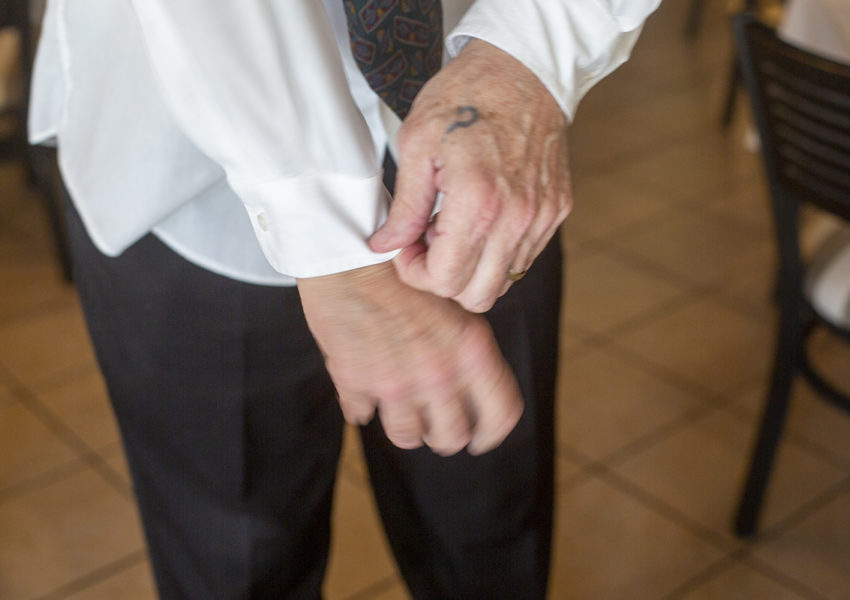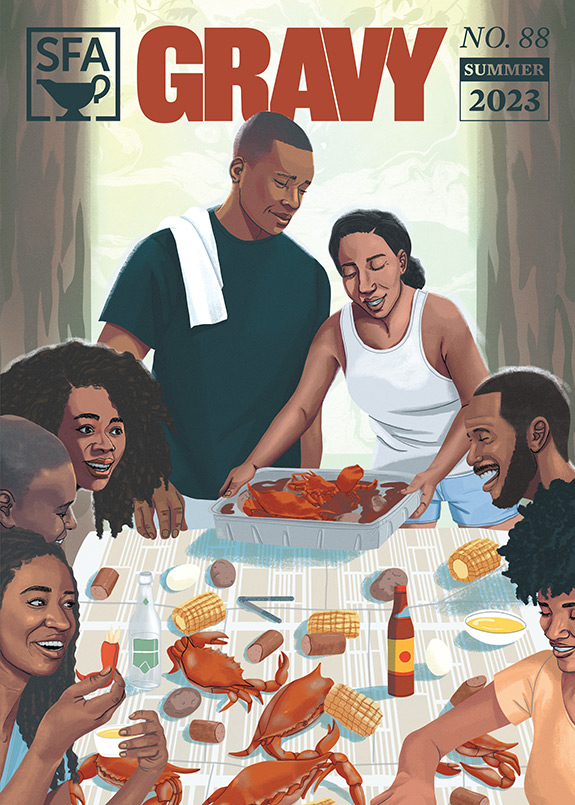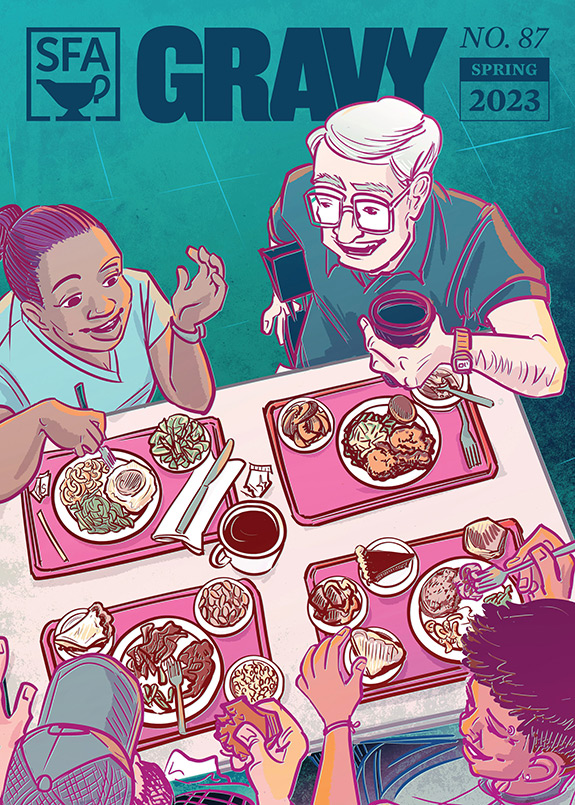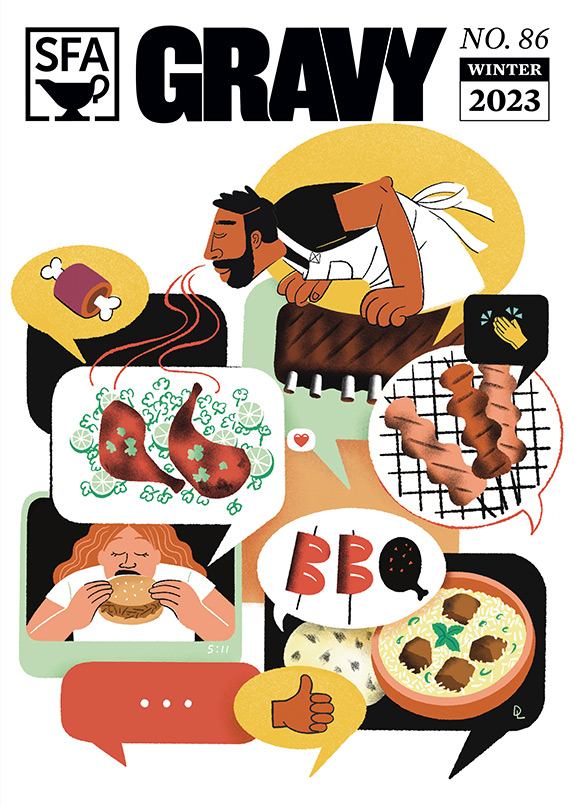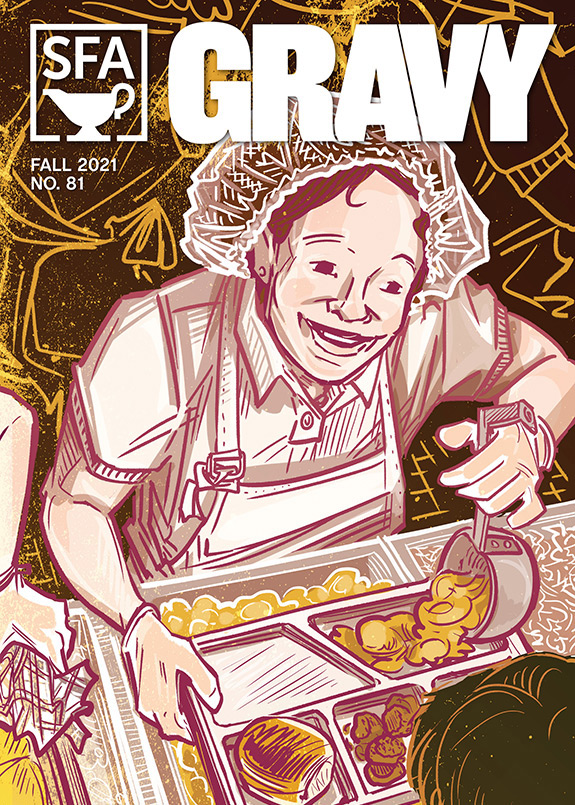
This piece first appeared in issue #56 of our Gravy quarterly. The author, Phil McCausland, is a contributing writer to the New Orleans Advocate. Thank you to SFA members for supporting the production of Gravy.
Creole Schnitzel
New Orleans and Germany, past and present
by Phil McCausland
The restaurant that served my personal comfort food—schnitzel, spätzle, and blaukraut—closed 20 years before I moved to New Orleans. Faded gold letters embedded in the cracked sidewalk still mark St. Charles Avenue near Canal Street, as does the restaurant’s iconic navy-blue sign. Both spell out K-O-L-B-S. That name, and the Creole-German fare associated with it, still loiters here. I know I won’t ever taste Kolb’s food, but a walk past the building often determines my next home-cooked meal.
The surname Kolb isn’t uncommon in New Orleans. Here, most folks pronounce it “cob,” which forces its bearers to spell it out and explain that, no, they have no relation to the famous restaurant, nor can they fathom what will happen to the old Kolb building. Kolb’s restaurant opened in 1899, and to New Orleans’ German population this seemed a grand entrance into the immigrant city. Since Germans arrived in Louisiana in 1721, many settled outside of New Orleans on what they called the German Coast, which hugged the Mississippi River. They founded villages that sounded like home: Karlstein, Hoffen, Augsburg, and Marientel. Today, the area is St. Charles Parish.
By the 19th century, Germans were the largest foreign-speaking ethnic group in Louisiana and called 12% of the population their kin. Meanwhile the German Coast swelled and prospered agriculturally. But the years weren’t kind to the German people’s customs, which often lost out to those of the more powerful cultures. Present-day New Orleans touts the influence of Spanish and French settlers on the city, including its Creole cuisine. More recently, the contributions of Italian, African, Native American, and Caribbean foodways have received their due. The struggle over the cultural pecking order lingers. Today, Germans have more or less withdrawn from that conversation.
Kolb’s was the last bastion of German-American culinary relevance: an institution famous for its ability to combine the entrenched Creole flavors of New Orleans with the cuisine of its homeland. One of its later menus claimed diners could “come celebrate Oktoberfest every day of the year at KOLB’s.”
Today the famous Kolb’s sign, now dark, continues to trail down three stories of balconies a few blocks from Canal. Once a proud beacon, it is now a sad reminder. The empty building rests, a ghost watching as the city fails, triumphs, constricts, and expands.
***
For the past four years, I have made my home in Mississippi and Louisiana. Back in Pennsylvania, my German mother finds this troubling. All she knows of the region is the thick heat and the difficulty she had understanding Southern accents when she first came to the United States. For 2 years in the late 1970s, she and my Army-officer father lived in military housing in Savannah. She recalls the legions of green anoles that died at the hands of their sliding-glass door and the tree frogs that stuck to the windows. She regularly implores me to move closer, to New York or Washington, D.C., and tempts me with the retelling of the dinner she made the night before: schnitzel and knödel, or käsespätzle, the thick egg noodles with Emmentaler cheese and caramelized onions.
Mom learned to cook by watching Oma, my grandmother, who continues to live on her own in the same village she settled in with Opa, my grandfather, after World War II. Both my grandparents were born and raised on the western edge of today’s Czech Republic. When the War broke out, Opa’s brothers, mother, and stepfather escaped to Bavaria. Opa, then 17 years old, couldn’t join them: The Wehrmacht drafted him into the service.
Soon after he arrived at the front, the Russians captured Opa, and he spent four years in a prison camp. When I was a child, he told me stories of dancing to keep warm, learning Russian from a children’s book, subsisting on potato skins, and enduring constant death threats from his captors.
He broke his leg in captivity, and the Russian and German governments negotiated his release. He found his family through the Red Cross and they took the train west to a city named Ulm, on the border of Bavaria and Baden-Wurtemberg, where he met my grandmother and found work rebuilding the city after the bombing raids. On the side of a hill in a tiny village a few miles away, he built a home that held three growing families as well as his mother and stepfather, Oma’s father, a cousin’s parents, and a few unmarried siblings.
The older members of the family passed away in the house and the younger generations moved out and built their own homes nearby: some a few houses down the street, others on the opposite side of the village. Two generations later, when I visit, I get the impression that I’m related to most of the people I meet. They all know me before we’ve made an introduction: I’m instantly recognizable as the only American.

Daniel Pratt erected the Kolb building in 1847—three stories, brick, with enormous balconies—to store and sell his own brand of cotton gins. A later owner turned the third floor into an art gallery, and then into the Louisiana Jockey Club, which gained a reputation for debauched revelry. Perhaps this notoriety is what attracted Conrad Kolb.
Seventeen-year-old Conrad entered New Orleans in 1891. At age 25, he bought Pratt’s building, changed the name to his own, and served the food he’d grown up eating in Bavaria. As he built and marketed Kolb’s, Conrad bought a farm on Gentilly Road, soon adding more land to his plot on the opposite side of the city in St. Charles Parish.
His wife, Mayme Schlosser, helped run the farm, providing the restaurant with its produce and farm-raised goose, pork, chicken, beef, and milk. The restaurant even bottled and served its own wine, a Bordeaux Claret. Kolb’s practiced vertical integration and farm-to-table long before those business strategies became vogue. In the old country, most people, no matter their profession, ate this way—to Conrad and his wife, a simple idea—and so that’s how they did it at Kolb’s.
Early menus didn’t focus on German fare exclusively. Dishes included crabmeat four different ways—Imperatrice, à la Dewey,à la Maryland, à la Cardinal—as well as Royal Squab en Casserole, Broiled Pompano à la Mexicaine, and Russian caviar. A few German offerings made their way through: German-style potatoes served as a common side; the lunch menu featured a Kalter Aufschnitt, or German charcuterie plate; and various dishes could be ordered “German-style,” likely meaning an occasion to use heavier and thicker mustards and deliver a punchier tang from vinegar or beer.
Slowly the restaurateur mixed the tastes of his birthplace with those of his new home, creating a German restaurant with a Creole flair. Red beans and rice were a constant on the menu, locals came to slurp down turtle soup and seafood gumbo, and the restaurant eventually offered Kolb’s Schnitzel: “Finest sliced leg of veal, pan fried, topped with sautéed lump crabmeat.”
Kolb’s became the preferred restaurant of early-20th-century New Orleans businessmen. Its location right off Canal Street, where the city’s businesses—such as the United Fruit Company—clustered at the time, provided a comfortable luncheon spot. As they left work, sometimes with clients, these early-century entrepreneurs would duck into the alley and enter through Kolb’s back door, to avoid the street and it commoners.
They’d slip through the kitchen, keeping one eye on the bubbling pots of tomato broth for chilled consommé and seafood gumbo and the other on the grill and its searing knackwursts, lamb shanks, schweinebraten, and tenderloin. Perhaps they wondered if they’d try the schweinshaxe, or pig knuckle, this time or stick with Kolb’s self-declared specialty, barbecue shrimp. As long as you knew which alleyway door belonged to Kolb’s, no kitchen worker would give you a second glance. Entering through the back door meant you were part of the extended family that coalesced around Kolb’s.
Inside, the decor read Teutonic: deep chocolate woods, large, intricately decorated beer steins on the walls, and German symbols, like the Emperor’s crown-toting black eagle emblazoned with a hefty K. A constantly running leather band connected the ceiling fans in the grill area of the restaurant, their motor resting in the floor above the dining room. The same fans once cooled an exhibition hall at the Cotton Centennial Exhibition of 1884. In 1995, the apparatus spun for the last time. Today, the John Besh restaurant Lüke, only a few blocks from Kolb’s building, pays tribute to its neighbor’s legacy. Fans with a similar system turn overhead, and the menu has featured jägerschnitzel, maultaschen, and kraut with a Creole vibe. But Kolb’s has no direct descendant in the city.

Put thousands of miles between people and those interwoven familial strands begin to unravel. The distance becomes more than geographic. After Oma suffered a stroke, she stopped cooking. She stopped doing her favorite crossword puzzle and gave up her frequent games of Skip-Bo and Mensch Argere Dich Nicht and Chinese checkers. Instead, she spent her days reading flimsy romance novels purchased from a newspaper stand at the train station or watching Catholic mass on television.
When Mom flew from the Pennsylvania to Germany to take care of her, she filled her bags with packets of chicken-flavored instant ramen because Oma would still boil water. When she returned, Mom cooked many of the meals she’d learned as a child: Wiener schnitzel, knodel (boiled dumplings), kartoffelsalat (vinegar-based potato salad), maultaschen (thin layers of pasta with a meat filling), spatzle (egg noodles), schupfnudeln (sweet, thick, gnocchi-like noodles), and sauerbraten (German pot roast). It was a special occasion when Mom made those dishes at home in the States, usually only preparing them for holidays, birthdays, or houseguests. In Germany, it was a daily expectation.
My 17-year-old brain, addled by marijuana smoke, muted my concern over the situation. I became intensely more interested in collecting Lionshead Beer bottlecaps and finding someone to sleep with me, selfishly unwilling to acknowledge that my family’s dynamic had changed. During the period Mom returned to the fatherland, my brother, father, and I ordered take-out or cooked meals in a Crock-Pot. Thanksgiving didn’t happen because we didn’t know how long it took to defrost a turkey. I’ve never gone a longer period of time without German cuisine—the food that fills my body with the sense of consolation that only home can provide.
After I graduated from high school and quit smoking pot, I moved to Germany to attend language school in Munich. My grandparents were ill: Oma was recovering from the stroke, and Opa suffered from prostate cancer and Alzheimer’s, which seemed to progress by the day. During the week, I’d attend classes and go to clubs on wild nights or or walk across the park to the Hirschgarten, the largest beer garden in the world, on quiet ones. Weekends, I often took the train to Ulm, a two-hour ride, and had one of my many cousins pick me up and bring me to my grandparents’ house, in which Oma now lived alone. My mother and her brother moved Opa to an assisted living facility in nearby Blaustein.
Saturdays and Sundays I spent reading, talking to Oma, or running errands in Opa’s old hatchback Renault: grocery shopping, picking up prescriptions, and visiting him in the facility. Usually he didn’t recognize me when I came in—I’d grown a thick beard and long hair. He’d always known me as the soft-cheeked kid with a weak grasp of German, the most American of his grandchildren.
He’d ask me kindly how my day had gone, tell me vague stories of his work building homes—always pointing with his right ring finger, which a chain tore off at the knuckle in a construction accident—or tell me jokes. I last visited him in early October of that year. We sat mostly in silence. He would stare at me and strain his eyes as if trying to solve a particularly difficult math problem someone had stenciled on my forehead. Then he’d shrug and sigh and look away. After this fourth exchange, his eyes caught a picture of my family that stood on his nightstand. He looked at me, then the picture, me, then the picture.
“Phillip?” he asked.
I leaned forward and nodded. “Ja, Opa.”
He told me to keep working hard and fell asleep.

During World War I, Kolb’s suffered from fervent anti-German sentiment. New Orleans and the rest of the country viewed German-Americans with suspicion. Act 114, which the Louisiana state legislature passed in 1918, made all expressions of German culture and heritage, especially the printed or spoken use of the German language, illegal.
Savvy New Orleans Germans “Americanized” their surnames, taking on their French equivalents. The German “Troxler” and “Zweig” became “Trosclair” and “Labranche.” Parents stopped teaching their children German language and history. Outside of Kolb’s, jingoistic locals allegedly strung up and burned a straw dummy of Conrad’s body, perhaps in reaction to news that Das Deutsches Gesellschaft, a New Orleans German group, had raised a hefty $7,000 for the war effort in their homeland, or maybe in rsponse to a pro-German rally held in Gretna around the same time.
The story of the Conrad Kolb effigy comes from an oral history, unconfirmed in contemporary news reports. Still, if we accept this as fact, it happened while Conrad sold Liberty Bonds to finance the U.S. war effort at an anti-German rally held in Lafayette Square. The speakers—local businessmen and community leaders—spat fire at the cheering crowd of 2,000, shouting phrases like: “Ninety percent of the Germans born in the United States and 100% of those born in Germany are unfaithful to this country.” “I believe every German alien should be interned, not in a palatial hotel, but where he should be placed at work.” And, “It would give me no hard feeling if you would hang every pro-German and make me the hangman.”
All the while, the German immigrant Conrad Kolb walked between the rows and personally urged the audience members to buy Liberty Bonds. By the end of the fundraiser, the crowd had raised more than $15,000.
When the United States entered World War I, most German immigrants maintained a low profile. At Kolb’s, Conrad adjusted his menu to subvert the antagonism, focusing on familiar dishes: shrimp cocktail, thick-cut steaks, crawfish étouffée, and fried fish. He replaced traditional German singing groups with jazz musicians. Kolb’s introduced jazz music to more affluent crowds while distracting them from the restaurant’s origins. Johnny De Droit, the cornetist and bandleader, began playing at Kolb’s in 1919. Thanks to this exposure, De Droit was one of the most sought-after jazz musicians in 1920s New Orleans.
These shrewd moves by Conrad made his restaurant a New Orleans institution, and the hostility of the First World War era didn’t affect it after the Treaty of Versailles. Perhaps by the interwar years, New Orleanians couldn’t remember the city without Kolb’s. Maybe they didn’t want to give up their lunch. Kolb’s flourished through the period and continued to serve growing lunch and dinner crowds. This marked a happy and successful period for the restaurateur until his death in 1938.
Even without its original owner, Kolb’s stayed the course. It gained such traction within political circles that famed New Yorker writer A.J. Liebling took notice. In his 1961 book The Earl of Louisiana, which investigated the fallout from Louisiana Governor Earl K. Long’s commitment to a mental institution, Liebling visited Kolb’s as many of the state’s leading politicians talked shop in the German eatery. By then, Kolb’s was a local fixture, not a foreign novelty. “In Kolb’s they served planked redfish steak, snapping-turtle fricassee, jambalaya and gumbo, as well as pig’s knuckles and wursts, so that their diapason is wider than a German restaurant’s in less favored regions,” Liebling wrote, adding that the atmosphere was “noisy and as full of politicians as rye bread of caraway seeds.”
***
Opa died three days after my final visit. I took off school, met my mom, and helped arrange the funeral. But I soon realized the help I provided was negligible. I was old enough to tackle what was asked of me, but never able to consider what needed to be done. This I found frustrating, as I grew aware of those responsibilities and my inability to shoulder them, living within that grey area of adulthood devoid of any self-certainty.
The family held Opa’s memorial at the village’s newest church. The funeral procession passed the old chapel he and I had gone to throughout my childhood, its windows dark. The whole village seemed to appear at the service to offer condolences, the pews filled by wrinkled faces I found vaguely familiar. After the service, we walked to the graveyard. Oma didn’t cry, but she held tightly to my arm as the procession came to a stop before the small plot in the front corner of the cemetery. At the house she’d given me a green wool sweater she’d knit for Opa but hadn’t had a chance to bring to the facility. I wore it then and rubbed its cuff between my fingers.
That night, I sat alone on the corner bench in the kitchen. I recalled Opa as he pulled out assortments of smoked meats from the fridge, telling me the differences between each and asking me which I considered best. I poured his favorite wheat beer into one of the glasses he’d kept at the top of the corner cabinet. I pulled short before I drained the bottle’s final swig, rolled it on the table so the sediment would mix, like he’d shown me since childhood, and dispensed the rest of its contents.
Oma would only shrug when I asked her about Opa over the next couple of days, sometimes removing her dentures, placing them on the table, and looking away, or saying something along the lines of “That’s that,” or “everyone I’ve known has died.” Her stories began to circle back to the War and her life before my grandfather, and to the men who’d courted her before they met. Mom and I would just nod. Eventually, Oma gave me Opa’s watch and wallet and told me to return to school. Before I left, she helped my mother with dinner: a sauerbraten, her first cooking attempt in over a year.
***
In the years following A.J. Liebling’s visit to Kolb’s, Conrad’s vision gave way. The new owners of Kolb’s turned up the kitsch, rendering the menu a stereotype of German tavern food. They added new types of schnitzels, though many of the famous New Orleans–influenced dishes lived on. In the 1970s they began hosting an annual Oktoberfest, reinforcing the German novelty.
As the French Quarter revitalized in the 1970s and 80s, Kolb’s popularity waned. It was the only German restaurant in the city, and perhaps this lack of competition caused its standards to plummet. Developers demolished the Kolb farm, an old Victorian farmhouse on fenced property north of the Industrial Canal, so that the neighboring Schwegmann grocery store could add a parking lot. The house and its Saturday “Tyrolean Night” parties had once been a fixture of New Orleans’ social scene.
The federal government declared the Kolb’s building a National Historic Landmark in 1991, but in 1995 the restaurant closed. For the past 20 years, various groups have come and gone, hoping to reuse the space. The late Dickie Brennan Sr., former owner of Commander’s Palace, took an interest at one time. Each attempt fades and and disappears as new ideas begin to float, leaving the structure unchanged and unfazed by the passing years.
Kolb’s style of German-Creole cuisine remains largely absent from the city, though restaurants like Lüke and Jager Haus gesture toward its legacy. This leaves me, a young man starting his life in New Orleans, starving for the food that makes me feel safe and loved. But I can’t ask the city to provide that for me. Now, when the desire grows too strong, I set out three bowls: the first filled with flour, the second an egg wash, and the last breadcrumbs. I heat oil on the stove and after pounding a pork chop flat, I coat it with each ingredient and a little salt and pepper. I place it in the pan and listen to the sizzle.


